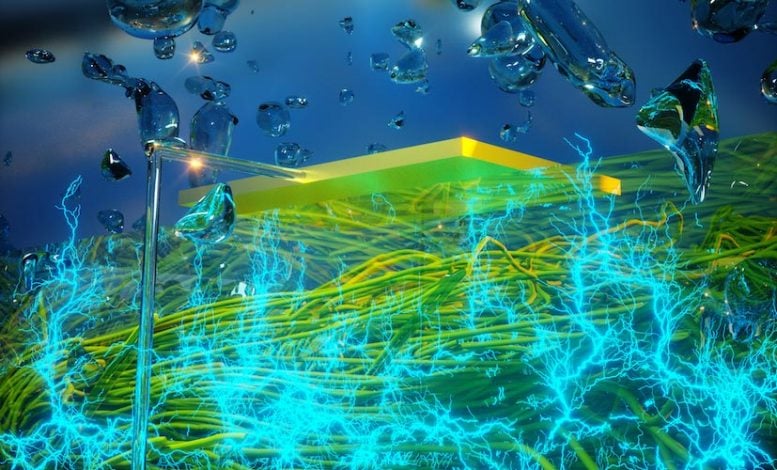
(Click image for full view.) Graphic image of a thin film of protein nanowires generating electricity from atmospheric humidity. UMass Amherst researchers say the device can literally make electricity out of thin air. Credit: UMass Amherst/Yao and Lovley labs
Renewable device could help mitigate climate change, power medical devices.
Scientists at the University of Massachusetts Amherst have developed a device that uses a natural protein to create electricity from moisture in the air, a new technology they say could have significant implications for the future of renewable energy, climate change, and in the future of medicine.
As reported today in the journal Nature, the laboratories of electrical engineer Jun Yao and microbiologist Derek Lovley at UMass Amherst have created a device they call an “Air-gen,” or air-powered generator, with electrically conductive protein nanowires produced by the microbe Geobacter. The Air-gen connects electrodes to the protein nanowires in such a way that electrical current is generated from the water vapor naturally present in the atmosphere.
“We are literally making electricity out of thin air,” says Yao. “The Air-gen generates clean energy 24/7.” Lovely, who has advanced sustainable biology-based electronic materials over three decades, adds, “It’s the most amazing and exciting application of protein nanowires yet.”
“We are literally making electricity out of thin air. The Air-gen generates clean energy 24/7.” — Jun Yao
The new technology developed in Yao’s lab is non-polluting, renewable, and low-cost. It can generate power even in areas with extremely low humidity such as the Sahara Desert. It has significant advantages over other forms of renewable energy including solar and wind, Lovley says, because unlike these other renewable energy sources, the Air-gen does not require sunlight or wind, and “it even works indoors.”
The Air-gen device requires only a thin film of protein nanowires less than 10 microns thick, the researchers explain. The bottom of the film rests on an electrode, while a smaller electrode that covers only part of the nanowire film sits on top. The film adsorbs water vapor from the atmosphere. A combination of the electrical conductivity and surface chemistry of the protein nanowires, coupled with the fine pores between the nanowires within the film, establishes the conditions that generate an electrical current between the two electrodes.
The researchers say that the current generation of Air-gen devices are able to power small electronics, and they expect to bring the invention to a commercial scale soon. The next steps they plan include developing a small Air-gen “patch” that can power electronic wearables such as health and fitness monitors and smart watches, which would eliminate the requirement for traditional batteries. They also hope to develop Air-gens to apply to cell phones to eliminate periodic charging.
“This is just the beginning of new era of protein-based electronic devices.” — Jun Yao
Yao says, “The ultimate goal is to make large-scale systems. For example, the technology might be incorporated into wall paint that could help power your home. Or, we may develop stand-alone air-powered generators that supply electricity off the grid. Once we get to an industrial scale for wire production, I fully expect that we can make large systems that will make a major contribution to sustainable energy production.”
Continuing to advance the practical biological capabilities of Geobacter, Lovley’s lab recently developed a new microbial strain to more rapidly and inexpensively mass-produce protein nanowires. “We turned E. coli into a protein nanowire factory,” he says. “With this new scalable process, protein nanowire supply will no longer be a bottleneck to developing these applications.”
The Air-gen discovery reflects an unusual interdisciplinary collaboration, they say. Lovley discovered the Geobacter microbe in the mud of the Potomac River more than 30 years ago. His lab later discovered its ability to produce electrically conductive protein nanowires. Before coming to UMass Amherst, Yao had worked for years at Harvard University, where he engineered electronic devices with silicon nanowires. They joined forces to see if useful electronic devices could be made with the protein nanowires harvested from Geobacter.
Xiaomeng Liu, a Ph.D. student in Yao’s lab, was developing sensor devices when he noticed something unexpected. He recalls, “I saw that when the nanowires were contacted with electrodes in a specific way the devices generated a current. I found that that exposure to atmospheric humidity was essential and that protein nanowires adsorbed water, producing a voltage gradient across the device.”
In addition to the Air-gen, Yao’s laboratory has developed several other applications with the protein nanowires. “This is just the beginning of new era of protein-based electronic devices” said Yao.
Reference: “Power generation from ambient humidity using protein nanowires” by Xiaomeng Liu, Hongyan Gao, Joy E. Ward, Xiaorong Liu, Bing Yin, Tianda Fu, Jianhan Chen, Derek R. Lovley and Jun Yao, 17 February 2020, Nature.
DOI: 10.1038/s41586-020-2010-9
The research was supported in part from a seed fund through the Office of Technology Commercialization and Ventures at UMass Amherst and research development funds from the campus’s College of Natural Sciences.

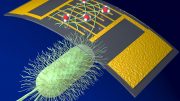

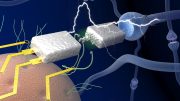

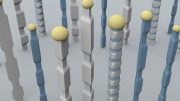

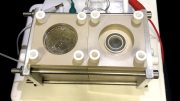
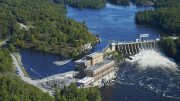
Aren’t there some significant issues with removing moisture from the air? Having no knowledge of the process, if one removes moisture from the air on a large scale, there seem to be consequences for plant life and, ultimately, human life.
If we collect all the dolts with your same thought process, put them in the same room with the dolts who think water vapor exhaust from hydrogen fuel will make too much moisture in the air, maybe you all will cancel each other out and get out of the way while science and technology save the flipping planet.
B.Demille, this is the most fantastically brilliant response I’ve ever read. Bravo!
I disagree. It seemed like a really rude response to someone who asked a reasonable question and even admitted they didn’t understand the process.
Into the cancellation zone with you Marco
Its not a reasonable question. Its an ignorant question. Right now we’ve got billions of machines all over the earth, using about 10% of the worlds entire energy consumption, that are pulling water vapor out of the air non-stop to no effect, we call it AC.
The answer is no. Any moisture is returned to the atmosphere in a cycle. Like evaporation that returns as rain, and then evaporates again. The water is not destroyed or removed and stored somewhere to never be seen again.
Water droplets that form on a cold glass of beer is probably more mositures being removed from the air then these devices. And that gets returned.
I think that this is the proto-type for the skin they will use on A.I. human like machines.
That is called “PERPETUAL MOTION”.
Would like to see a patent…
Thing is, global warming is putting vast amounts of energy into the atmosphere in the form of water vapor. For each tiny rise in ocean surface temperature, many terrajoules of energy rise as water evaporates. This results in extreme weather events. So, reducing global water vapor should directly mitigate climate change…
ll you guys would just do your share, just the combined effect of all those billions of exhaled oh oh’s would more than make up for what the devices remove from the air. In fact, would you please oh oh over there, next to the humidity powered generator?
Thinking the same thing. Removing moisture from a rapidly warming planet just don’t seem like the logical approach.
This temporarily pull the water vapor out of the water cycle. You are not destroying the water, it is pulled out of the air, but it comes back later as the cycle completes. No water molecules were harmed in this experiment.
Okay, first of all you have it backwards.
(I wish people would use google for just 30 seconds before posting)
Water vapor is the most important greenhouse gas. It controls the Earth’s temperature. Water vapor is the largest contributor to the Earth’s greenhouse effect. On average, it probably accounts for about 60% of the warming effect.
Therefore these devices would help cool the earth down.
Google it.
Water vapor is the most potent greenhouse gas. It traps about 4 times more heat than CO2. So rather than providing a cooling effect it has a very pronounced warming effect.
But no matter, this process won’t remove enough water vapor to have any effect, positive or negative on temperature.
I thought this was a science blog.
So, it isn’t clear from the article, are the microbes themselves part of the solution or just something they produce? In short, is this an end-user device that relies on a living thing to behave in a certain way inside the device itself?
Assuming for the moment it is not a “live” device with microbes inside producing protein nanowires, does it require replenishment? Typically, to produce energy, some substance is consumed, is that the case here? How do you “refuel” it or does it die after some period of time like a battery?
Also, what point is there not enough moisture in the air for it to work? The Sahara is not as dry as the Atacama is, will this work in the driest place on earth? Is there any degredation of its output in dryer air?
What voltage was produced and how many amps can it deliver?
Asking the important questions.
If the link works, here’s their published paper in Nature, with some of that answered in the introduction:
https://www.nature.com/articles/s41586-020-2010-9
I expect it is so small that that only thing it will ever power is their probability of generating more grant money.
You guys realize that the water isn’t “destroyed”, right? It’s using the moisture in the air, not removing it.
@John N I think that ‘energy’ isn’t destroyed and therefore, yes the water can be destroyed if it is converted to some other form of energy instead, like oxygen and hydrogen.
Can you explain how oxygen or hydrogen is a form of energy?
They are both flammable.
Size to power output? Kept waiting and they never said. If this device is producing electricity from ambient moisture, how much energy is available is six square feet? .25 watts? Ten watts? 100 watts?
This is the major determining factor, if it takes two suitcases full of this device to run an electric toothbrush how many folks will buy? This is a very interesting take on energy production and is highly encouraged, but the power to weight ratio may make it exceedingly impractical compared to other methods.
If the link works, here’s their published paper in Nature, with some of that answered in the introduction:
https://www.nature.com/articles/s41586-020-2010-9
That’s why computers never really caught on. The first ones were so big….
Philip, give them a few minutes to improve the technology. Don’t give up.
Just remember, Earth is a relatively closed system. Taking energy from one location will have consequences in another. Let’s start considering consequences before we “revolutionize” the world. (Interesting tech though….)
“Just remember, Earth is a relatively closed system.” – That is absolutely incorrect. More energy arrives from our Sun than we use in power everyday. If we could capture 10% of the Sun’s energy, we could power and utilize it, we would not need any other energy source. You can not create or destroy energy, only change the form. That heat from the Sun “Lost” in creating energy is not lost, it would come back out when electricity is used. High School physics, not rocket science here.
Global warming creates enormous amounts of water vapor in the atmosphere. It adds to global warming. SOOOooooo………
I think you all need to read the article again. This is groundbreaking, to say the least. READ AGAIN before posting questions, because the answers are there.
It requires a subscription to read the full article. So maybe some helpful person would answer the questions here.
I remember reading about this in 2017. I also remember imagining “The future” with this technology. 3 years later I read this article and hope to see this emerge before either A. The people working on it die. or B. I die.
Regardless of all potential challenges related to this invention it is still very innovative, promising and definitely worth further studies. Let’s keep an open and positive mind into the future. 🙂
” if it takes two suitcases full of this device to run an electric toothbrush how many folks will buy?”
I don’t think the intended market is portable power sources for your toothbrush. How many suitcases does a nuclear plant take up for your toothbrush? Or a coal furnace.
All the nay sayers on here are being ridiculous.
Wow, you people! There’s nothing to fear in reacting humidity with nanowire. This is actually quite exciting.
A simple remark on the power output capability or potential would be sufficient… But noooo, we have to make a long article without actually saying anything relevant.
Hehe agreed. If the link works, here’s their published paper in Nature, with some of that answered in the introduction:
https://www.nature.com/articles/s41586-020-2010-9
There is, of course, no such thing as free energy. The article doesn’t really explain how this isn’t a perpetual motion device. Obviously it’s gaining energy in the form of electricity, but where exactly is this energy coming from, and where is it going missing?
My best guesses are that (a) this fabric/device/whatever-it-is-called is harvesting static electricity; (b) either the protein or the nanotube or both will degrade over time.
There may, or may not be any such thing as free energy. There certainly is such a thing as cheaper energy. If you include all the true costs of petrochemical energy.
The nano wire absorbs some amount of water. At some point does it become soup? How do you recharge it?
There is no ‘free lunch’ What powers this?
some sort of gradient power source-how long do the nano wires perform
It requires a human host.
I’m not sure why every promising scientific breakthrough is met with Neanderthal like ignorance instead of considering it might actually be valuable and helpful. I’m no scientist but it’s irritating to see less skilled people shoot down ideas before knowing what they’re all about. Guys keep at this.
People actually interested in science need evidence and details before they get all “excited.” We’ve all been misled before by sloppy documentation and failure to release all the data and methods.
after it absorbs water you hand squeeze it and it will reabsorb the water and generate more eletricity. Or you just use yor hands and turns a crank on a traditional generator/dinamo and generates 17X more energy, and faster
The abstract says that the Output Voltage is 0.5 volts and the Output current is 17 uA which figures out to 0.085 Watts per square meter. For comparison, average efficiency solar panels put out 150 to 200 Watts per square meter or about 1800 times more. Of course the solar panel work intermittently and this development could run 24/7.
Univac, the first computer, was gigantic, primitive, and cost up to 1.5 million bucks. You aren’t exactly reviewing the deluxe home version here.
Ok, to clarify for those that haven’t read the linked article, the nano wires are made by, and harvested from, the bacteria during the manufacturing process, the presence of moisture within the nano wires causes a voltage gradient to occur so no H2O is actually ‘consumed’, and the power harvested is very small per square centimetre of area but as the film is only nanometers thick it can be scaled in a linear fashion to deliver useable current. Whether or not there is a consumable element to this process the minimum level of atmospheric humidity required and other technical details are behind a paywall I am unwilling to bypass (unfortunately, unlike a certain border wall, this one can’t be blown over nor scaled by a cheap ladder), I hope this helps…
Simple fact of physics ….. There isn’t enough energy in the water vapor in a room even at 70% humidity to light a 100 W light bulb for even a minute …..
Energy Out is ALWAYS dependent on Energy In + losses entailed in the conversion …. The Energy Density just isn’t there …. You cannot create more energy than already exists in a given space
It is not hard to imagine a process that recaptures the energy put into a liquid to form a gas, or even dispersed droplets of water, but only one half of this process is identified by the article. Presumably the hydration of the protein creates a potential difference that can be used to move electrons. But what happens to the water once it is bound to the protein? Once the protein filament is hydrated, where does the energy come from to dehydrate it so that it can be hydrated again? The article identifies a source, but not a sink. I don’t mean to imply that this sounds like specious bogus nonsense. Free clean energy. Wonderful.
The 17 uA is per square centimeter which should be equal to .0017 amps pet meter for an output of .00085 Watts per square meter
The device puts out 17 micro amps per square meter at half a volt. That works out to 0.08 watts per square meter, less than 1/1000 the output of a solar panel. If you had 10 solar panels for your house, you would need 10,000 of these.
From the article:
“current density of around 17 microamperes per square centimetre”. (*Not* per square meter).
The rest of the math looks ok.
just note that this is much thinner than a solar panel (“7-micrometre-thick film”) and doesn’t have to lay flat facing the sun (maybe roll it up?)
If any of the following theories were correct, why do these guys say they don’t understand the process. Besides the government in the secret space program already know how to generate free energy. Astronauts have already said so. They just won’t let it out because then they can’t make any money… Money makes the world go round
If Joe is right, and it works out to 1/1000 the output of a solar panel of the same area, but
1) It works 24/7, so let’s call it 1/500
2) It’s in its infancy and likely to become at least 10 times more efficient, so let’s call it 1/50
3) They are super thin, so you could likely put 50 sheets in a 2 inch thick panel, so you could get to 1/1
4) You can put them anywhere the sun never shines; underground caves, places with near-perpetual shade etc., north and south poles, and other locations where competing systems don’t thrive.
If it covers a couple of percent of overall needs, eventually at a cost effective price, what the heck… why not add it ?
I could be out to lunch on the math (not a scientist) but seems like a better use of science than coming up with more efficient fracking methodology, so I’m going out on a limb and giving it a thumbs up.
My main issue about pulling energy out of thin air comes at me like another invention of a perpetual machine. The only way to show that it really works is to write out the energy balance equations showing where the energy is coming from and how it is harvested using this new technology. Psychrometric charts for example showing the energy entropy states and moisture content would really help better convince the skeptics that the technology works, at least in principle, not through smokes and mirrors.
It would be nice to see the energy equations involved in generating the electricity!
Robert Neuman invented a motor device using the river of power from a magnetic field[lines of flux]to power a perpetual motion machine that actually put out more power, than it used. It was unprecidented at the time[1970’s]and might still be. The government f@#ked him out of patents,scientists could not believe what they were witnessing. Defied laws of energy. this news should have been on the front page of every publication known to man. Never massed produced. forgotten. These ideas and inventions are brilliant, All depends upon who will let them live.
1) Some of the comments on this article were just complete gold
2) There’s no way this works. Color me skeptical, but how many energy breakthroughs have we heard of in our lifetimes that had some horrible side effect (wind, solar, hydrogen, etc.). I’m just not gonna get too wired up about it- some click bait headline.
Absolutely right. Let me review what is happening
The carbon in the microbe is reacting with water and producing electricity.
Pretty sure Rudolf Diesel did that around 1880
I saw a comment saying this probably has bad side effects but, with the processes outlined in the paper what side effects could this possibly have ? Its fully renewable.